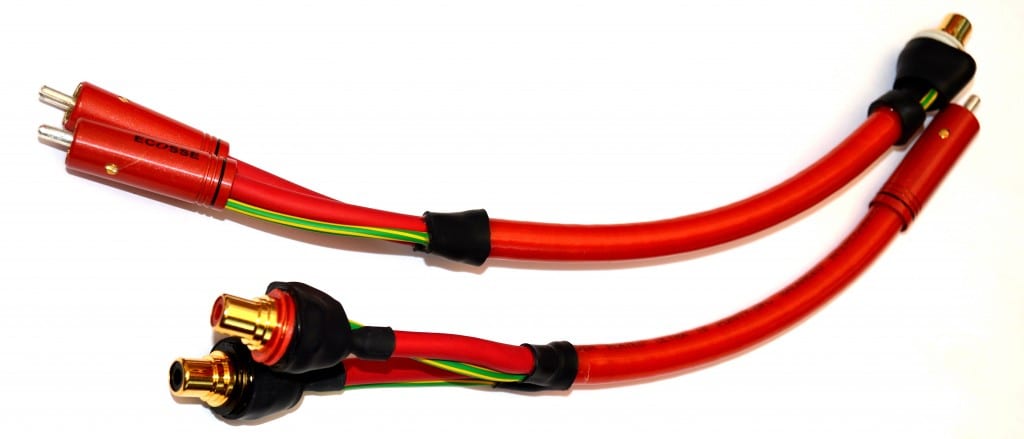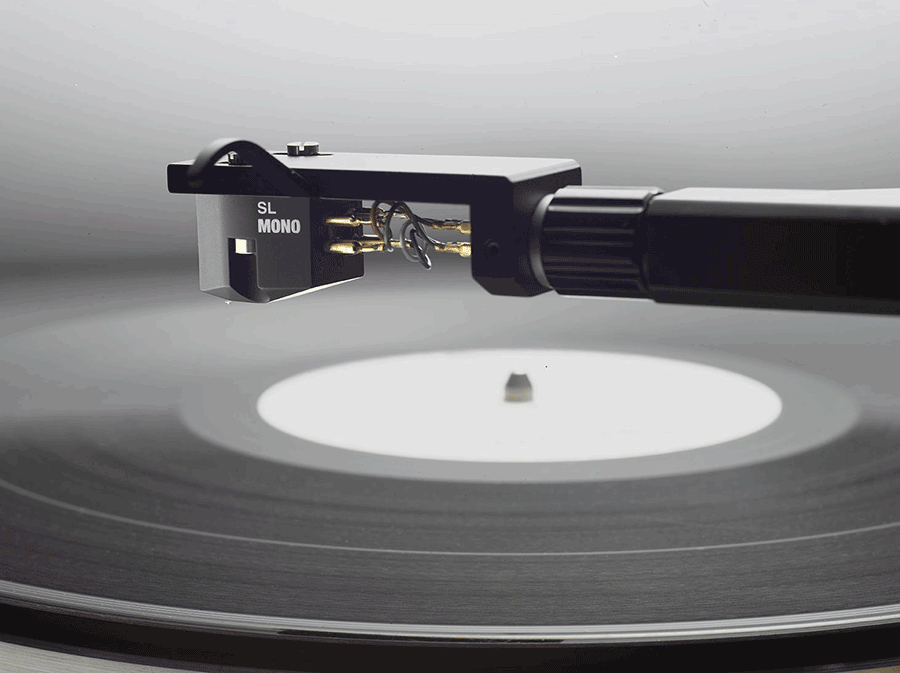I recently reviewed the Clearaudio Performance DC turntable and arm combination, even attempting some mono LPs; something I very rarely do. To make it all more acceptable to my stereo ears I used the new Ecosse Tru-mono turntable interconnect. This weird looking combo creates a summation of the Left and Right legs and comprises a combination of stereo RCA sockets (to connect to the turntable arm interconnect) which are joined into a single output itself terminating in a mono RCA plug, which in turn connects to an RCA socket which then duplicates the new mono signal to a pair of RCA output plugs. So Tru-mono turntable interconnect is indeed a cable of two halves, and available in three choices; the Premier, using the red Baton Mk2 cable, the Audiophile, based around the Master Reference, and the Ultra Audiophile, based round The Legend Interconnect. Prices are £80.00, £449.00 and £1450.00 respectively. In the Premier version they use their proprietary MACH1 RCA deep copper plated plugs together with gold plated over brass sockets. In the Audiophile version they use their proprietary Monocrystal™ Copper MACH2XS RCA plugs together with Neutrik gold plated sockets, and the top line Ultra Reference version Ecosse use their Monocrystal™ Copper MACH2XS RCA plugs together with DH Labs ultra gold-plated pure copper sockets. All the versions come complete with plenty of shrink-wrap to hold it all securely in place. The total length of 18 inches means that it is all easily hidden behind your equipment, where it should always be, anyway. Ecosse prides itself more on the sound quality than on simply making it all look pretty, which is an enviable quality I believe. Their Big Red mains lead looks like it has been cut off a lawnmower, but it is the best mains lead I have ever had the pleasure of testing.
For this review I chose the cheapest version of the Tru-Mono, and luckily owning a pair of red Baton cables I was able to ensure the same cabling all the way to my Manley Steelhead phono-stage. Obviously for reasons of this review I refrained from pressing the mono “sum” button on the Manley, instead relying on this cable to do all the work. Whereas a mono button on a mixer does more than just joining the two legs, rather ensuring constant impedance and preventing sum and difference frequencies, this cable just joins them. Let me explain. At university studying for B.Mus I composed a series of pieces under the acronym SINOLIMI “Sines NOn LInearly Mixed”. In my compositions if I joined 500Hz and 800Hz signals, I also created 1300Hz and 300Hz artefacts, otherwise known as heterodynes, which coloured the sound and gave it the timbres and textures I needed. I did a similar experiment with these cables before commencing listening to vinyl. The artifacts were certainly there, but not so much as to stand out and colour the sound.
In theory, then, this cable shouldn’t work, but please do read on. One of the results of adding the left and right signals should mean that hard left and right information should cancel out. This famous trick is often used in reverse to get rid of the mono middle voice in those “Karaoke” buttons on Amstrad-esque MIDI hifi players, and later in the Audacity “vocal remover” setting. By adding together the record clicks on the left and right legs, which are never perfectly phased, the end result is a reduction in sound. I remember at the BBC gramophone library back in the 80’s having an aged Garrard scratch remover, using a different technology of reducing sudden peaks, the crackles, which made for much easier listening. What would make for even better listening in mono now, though, would be having mono clicks. Listening to a mono recording with crackles appearing everywhere other than where the music is, is like turning up to a wedding in a black suit. It just doesn’t feel right. Now, listening to my aged and moulding Capital Records “Further Studies in High Fidelity”, complete with its comprehensive 12 page introduction by Charles Fowler from High Fidelity Magazine, I was suddenly cast back to the 1950’s and equally suddenly the music started to make a lot of sense. Surprisingly I didn’t hear artefacts from the heterodyning. This £80 cable genuinely made the music come alive. Chavez Toccata for Percussion was easier to understand. Only very tops from the glockenspiel were slightly subdued. Charles talks in his introduction that “while we know great deal about [hi-fi] there is still much to be learned. In many ways, sound recording and reproduction seem relatively simple by comparison”. Whilst he might have been confused by what he was writing, this music certainly wasn’t. My 1964 7” Louis Armstrong disc gave much more musicality now than my Dansette from the 60’s ever could. The sound focussed in a way it cannot do in stereo. Scratches just disappeared to a level where they were either covered up by the music or I could just simply ignore them. I really couldn’t imagine mono to sound this good. My only concern was increased hum, though I was able to make a few connections to reduce this. The 4 trumpets and 5 saxophones in YMO Sumac’s rendition of Bo Mambo took me back into a world of taffeta, nylon, rayon and shellac. Arthur Gleghorn’s flute in Saint-Saen’s ‘The Aviary’ (from Carnival of the Animal’s conducted by Felix Slatkins) was superbly clear and William Pittsburgh conducting the Pittburgh Symphony Orchestra in the Stravinsky Rite of Spring was equally compelling, and forceful; the decreased noise-floor a welcome addition to the music. I didn’t worry that the music was mono; I just enjoyed the music because it was much more focussed.
Only when turning back to playing my mono records in stereo did I hear an apparent greater dynamic range and slightly improved top-end, but those horrible stereo crackles returned. Whilst I am fortunate in being able to press the “sum” button on my Manley phono stage, doing so also still took away some of that ‘top’, and anyway this £80 cable will be a cheaper solution than having to buy a new phono stage complete with a mono switch. So, should I take this cable seriously? Actually, I think this is a clever and original product, and the sort of thing you might see presented on Dragon’s Den. But, would I cast it alongside the single glove that you buy put on your right hand when you travel abroad to remind you to drive on the correct side of the road, or the roller skates you strap to your knees to help you going from one kneeling job to another at high speed? Probably not. Perhaps if the cable had a mono-stereo switch built into it so that if you happened by chance to perhaps play anything in stereo then you could do so without swapping cables over, now that might be something I’d invest in. The quality of the cables is not in debate here. Ecosse produce some of the most amazing and modest looking cables, and if you really wanted to spend £1450 to play mono then I certainly wouldn’t argue with you. But £80 to stop your mono discs from being played in stereo, now that really is a good idea.
Sound Quality – 8.4/10
Value for Money – 8.4/10
Build Quality – 8.0/10 (built to last, but a bit DIY for my liking)
Overall – 8.27/10
Janine Elliot



















































































































































































You must be logged in to leave a reply.